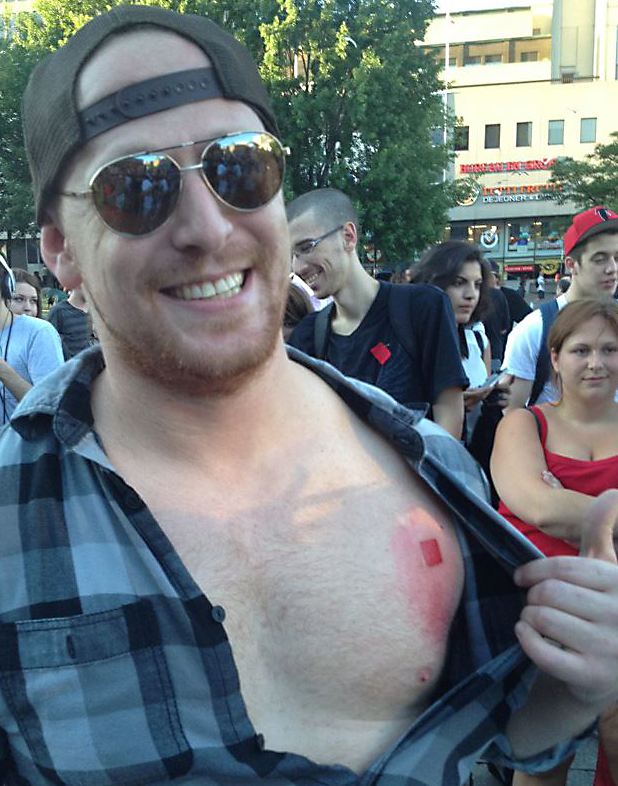Behind every tattoo is a story.
This holds true for the 107 people who had Quebec’s infamous red square permanently inked on their bodies during a tattoo-a-thon in Parc Émilie-Gamelin in Montreal June 19.
For some it represented an international journey, for others, the plight of students but for Montreal blogger and organizer Gabriel Roy, it was more of a joke.
When politicians made statements that the Quebec protests would disappear soon enough, Roy said he organized this event to show the permanence of the movement.
“It was just a big ‘fuck you’ [to politicians],” he laughed.
The tattoo-a-thon is the most recent one of Roy’s comical protests. He has also organized the first nude protest and a flash mob protest.
It’s not all jokes for Roy. As he points to the red square tattooed over his heart and explains his sleeve (there’s a tattoo for each of his daughters), he also points to his rib cage.
He said this was where his ribs were fractured after being beaten by four police officers during a peaceful protest.
Instead of responding with violence, he said, he chose to produce a mocking online video.
“The best answer is often the funniest,” he said.
The tattoo event’s Facebook page is flooded with photos of students sporting the red square tattoo on their backs, their chests, their legs and even their hips. Students from colleges in Montreal and Quebec, according to their Facebook accounts, leave comments of solidarity as their tattoos heal.
The red square itself dates back to 2004 student protests, according to the Collectif pour un Québec sans pauvreté (Collective for a Poverty-Free Quebec). It stems from the phrase “carrément dans le rouge,” meaning students were squarely in the red because of the debt situation.
For some, the tattoo has nothing to do with students at all.
“I did the tattoo for a different reason than all the demonstrators,” said Chico Peres, the production manager at CUTV, Concordia University’s campus and community television network.
Peres received a grant from the Portuguese government to work at any network in the world and said he chose CUTV. He started working in July 2011 and the protests have been a defining part of his work.
“I got [the tattoo] to mark the moment we are in right now,” he said in the CUTV newsroom.
He added that it’s symbolic of all of his time at CUTV and his journey to Canada.
“I’m here. I give my heart and soul and I want to immortalize it.”
Peres’ tattoo on his wrist wasn’t done properly and the resulting scar will remain there forever. He said he doesn’t mind so much as it contributes to his changing definition of what the tattoo means to him.
No matter what the story behind each person’s tattoo of the red square is, they all seem to be inspired by transforming moments with echoing impacts.
Roy didn’t even wear a red square at first because it only boosted the premier’s popularity and the protests did a disservice to the student movement, he said.
However, with the violent responses, the creation of Bill 78 and the ongoing protests, he said it’s too late to turn back.
Roy will be the first to admit that not everyone who got the tattoo thought a lot about it, he said.
Still, he said he hopes his tattoo will serve as a reminder to him if he ever stops believing in all that the red square stands for: fighting corruption in the government, exposing police brutality and pushing towards a better future for his daughters.
“C’est pour qu’il n’oublie jamais,” his daughter said, meaning, “It’s so he’ll never forget.”






